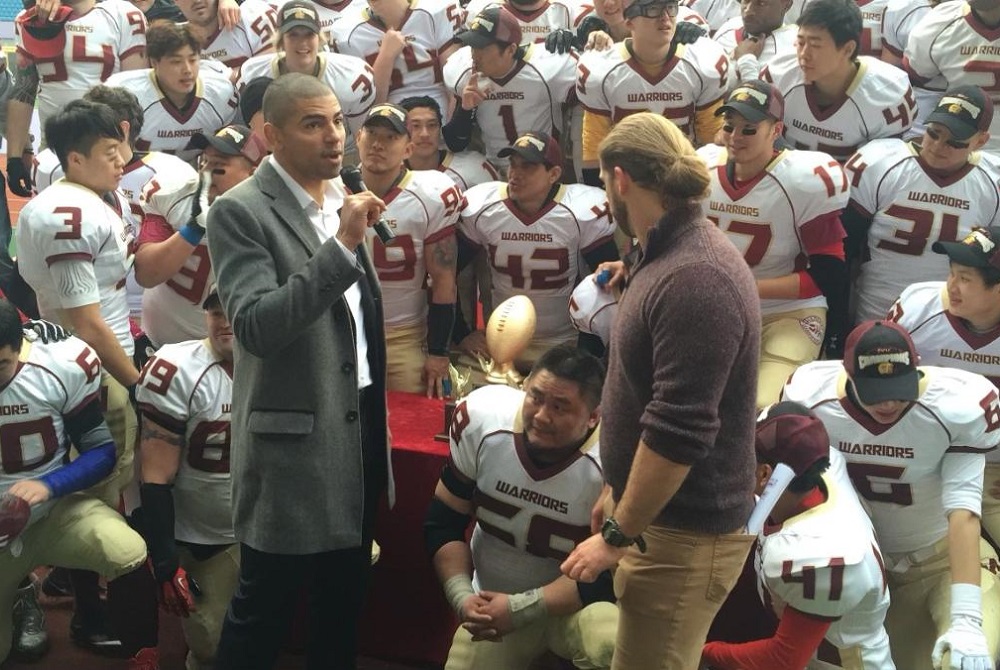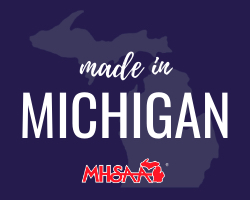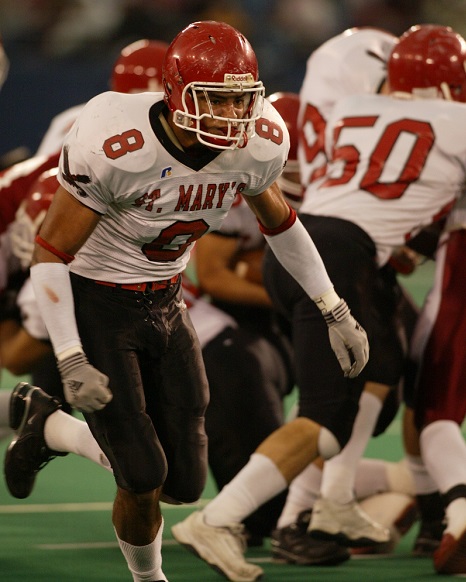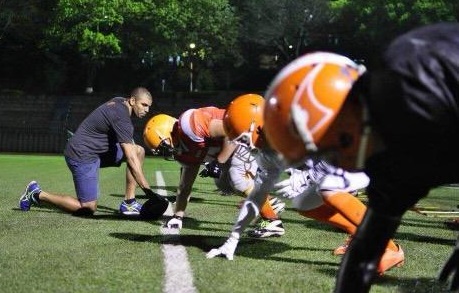
Neighbors Rally, Revive 'Community' Stadium
August 31, 2015
By Geoff Kimmerly
Second Half editor
MOUNT PLEASANT – Josh Wheaton stood admiring the Community Memorial Stadium grass a little less than a year ago, and he knew what was coming next.
The weeks of trampling to come would produce the same result as every year beginning in mid-September.
 “I’m looking at it and thinking, I can’t believe a week ago it was exactly the way you’d want your yard to look,” said Wheaton, a varsity assistant coach for Mount Pleasant’s football team. “And now, it’s this. It’s the same every year. I knew it was coming – and by weeks 7, 8, 9, we were going to be playing in a mud pit.”
“I’m looking at it and thinking, I can’t believe a week ago it was exactly the way you’d want your yard to look,” said Wheaton, a varsity assistant coach for Mount Pleasant’s football team. “And now, it’s this. It’s the same every year. I knew it was coming – and by weeks 7, 8, 9, we were going to be playing in a mud pit.”
But less than a year later, as the team prepared for its first game last week, Wheaton and his Oilers – and co-tenant Mount Pleasant Sacred Heart as well – all were enjoying something that defied any expectation: a project pulled off so quickly, it spoke well to the name of the stadium the schools share.
In less than a year, supporters of Mount Pleasant High and Sacred Heart Academy raised $600,000, secured another $300,000 in donated work, and assisted in the transformation of the stadium from an aging landmark built 50 years ago to what should again be one of mid-Michigan’s athletic jewels for years to come.
The schools reopened the stadium Friday for a doubleheader. Sacred Heart fell to rival Beal City in the opener, and Mount Pleasant then defeated Midland Dow to finish a night that saw more than 5,000 fans pass through the new gates and witness the official debut of stunning two-tone green turf that served as the main focus of a renovation that has only just begun.
“It is a community that believes in young people and certainly believes in athletics,” Mount Pleasant athletic director Jim Conway said. “I think being in a college town (with Central Michigan University), there’s that collegiate portion to it where the kids start (here), and many end up matriculating over there. And we sit right here in the middle of the city, and being the shared facility, that is kind of the focal point. We were able to use that and people latched on and wanted to be a part of it, and we’re still going.”
If you rebuild it …
Community Memorial Stadium opened in 1965 as the shared home of the Mount Pleasant High and Sacred Heart football and track and field programs. Prior to its construction, the programs had a variety of homes – CMU’s Alumni Field for the Oilers and at times the Irish, who also played at Fancher Field and at Island Park going back to at least the mid 1930s.
The new stadium construction was funded solely by the community and opened Sept. 25, 1965, for what ended as a 26-26 tie between Mount Pleasant and East Lansing. The field has remained a point of local pride since, with junior high games and the town’s rocket football teams also taking regular turns on the grass.
 Most weeks during the fall see the stadium host three or four games. But Wheaton said last fall there were three weeks during which 11 games were played.
Most weeks during the fall see the stadium host three or four games. But Wheaton said last fall there were three weeks during which 11 games were played.
It’s not that all the activity tore up the field. But it didn’t allow the grass time to regrow after the older kids did their damage on Fridays and Saturdays.
All of that caused Wheaton to casually suggest last fall to Oilers coach Jason McIntyre that the grass should be replaced with synthetic turf. Never will happen, McIntyre responded. That conversation had been had before – including briefly when a bond was passed eight years ago that led to the repair of the locker rooms, concession stand, press box and track at the stadium – and talks about going to turf had never progressed past the idea stage.
Wheaton told his boss he’d take care of it, but nothing more was said on the topic for a couple weeks … until someone else brought it up, and McIntyre joked that Wheaton was all over it.
This time, he ran with it.
In October, Wheaton formed a committee made up of supporters of both schools. They decided they would need to raise all of the money for turf over six months – by April 1 – and split into sub committees to handle fundraising and construction.
“When I first heard about it, I was a little skeptical,” said Sacred Heart athletic director and football coach Rick Roberts, who like McIntyre is a second-generation football coach in the 26,000-resident town and has led his program for 23 years.
“I wasn’t sure we could raise that much money in that short of a time; the economy isn’t the greatest at the moment. But when I went to a meeting, and saw the energy that was around the table, I knew it was going to happen.”
Pillars of the Community
Mount Pleasant High is a Class A public school with about 1,070 students. Sacred Heart is a Class D Catholic school with about 140 enrolled. In those ways, they couldn’t be more different.
But kids at the schools grow up playing Little League baseball or youth basketball together, and a number of Mount Pleasant High families attend Sacred Heart Parish.
 And there was plenty of work for all to do, and do quickly.
And there was plenty of work for all to do, and do quickly.
With money rolling in, the old grass field would need to be dug out to eight inches below the surface. Materials would need to be brought in to refill the base where the synthetic surface would be laid.
Pennsylvania-based ProGrass did the turf work, but the rest was done with local hands and equipment.
Wheaton made contact with the Isabella County-based Morey Foundation, which pledged to match $200,000 in donations from the community. Committee member Doug Moore is a president with Fisher Companies, which does concrete and asphalt work as well as construction transportation in mid-Michigan, and his company contributed much of the $300,000 in in-kind work.
McGuirk Sand-Gravel, which had also contributed when the stadium originally was built, hauled out the old field, while Malley Construction built the concrete curbs and long jump pits. Contractor Eric Borodychuk constructed the new entrance. Straus Masonry continues to build the wall of bricks and pillars purchased by donors, and other volunteers landscaped the hill near the front gate.
“If you don’t have those kind of people in your community, this doesn’t even get off the ground,” Wheaton said.
“We thought that was there,” Conway said of the support. “This is proof.”
Still work to do
Oilers senior Zach Heeke remembers teammates turning ankles on the old practice fields in holes left over from shot put tosses the previous spring.
Those are more or less a memory now – the varsities for both schools practice daily at the stadium, sometimes splitting the field down the middle. The subvarsity teams still practice on other fields, but the track and field throwing areas are inside the stadium as part of the new construction.
 Heeke is more connected to athletics than a typical high schooler – his dad Dave Heeke is CMU’s athletic director – and Zach appreciates greatly what’s gone into his team’s new home field.
Heeke is more connected to athletics than a typical high schooler – his dad Dave Heeke is CMU’s athletic director – and Zach appreciates greatly what’s gone into his team’s new home field.
“It’s an honor, for sure. It gives us a lot of motivation,” Heeke said. “All the people who donated money to have this happen, we have to show them that we’re good enough and we want to play here, and we’ve got to play for them. It’s awesome to think of all the people who come to our Friday night games, and maybe they’re not showing up in the stands, but they’re on the wall and they’re thinking about us.”
Two members of the original 1965 stadium committee attended a celebration of the new field Thursday. Roberts, who remembers the stadium’s initial construction, believes the original contributors who have since died would be “thrilled” with how the current community has taken up their work and improved upon it.
Bricks and pillars continue to be sold, for as little as $250 and as much as $25,000, as part of the Pillars for the Community fundraising group the renovation committee set up. That money will fund a phase two that likely will include replacing original concrete and possibly adding new bleachers. Both schools are contributing together annually to a fund that will allow for the necessary regular maintenance and then replacement of the turf in 10-12 years.
“(The committee) all wanted the same thing. And when you get a bunch of ex-athletes in a room who all want the same thing for kids in the community, it goes pretty well,” Conway said.
“It’s just been a Mount Pleasant family, if you will."
 Geoff Kimmerly joined the MHSAA as its Media & Content Coordinator in Sept. 2011 after 12 years as Prep Sports Editor of the Lansing State Journal. He has served as Editor of Second Half since its creation in Jan. 2012. Contact him at [email protected] with story ideas for the Barry, Eaton, Ingham, Livingston, Ionia, Clinton, Shiawassee, Gratiot, Isabella, Clare and Montcalm counties.
Geoff Kimmerly joined the MHSAA as its Media & Content Coordinator in Sept. 2011 after 12 years as Prep Sports Editor of the Lansing State Journal. He has served as Editor of Second Half since its creation in Jan. 2012. Contact him at [email protected] with story ideas for the Barry, Eaton, Ingham, Livingston, Ionia, Clinton, Shiawassee, Gratiot, Isabella, Clare and Montcalm counties.
PHOTOS: (Top) The Community Memorial Stadium turf includes the logos of both its home teams, the shamrock for Sacred Heart and the oil derrick for Mount Pleasant High. (Middle top) Supporters have given to the stadium and the schools' players in multiple ways, from buys bricks and pillars to hanging signs. (Middle below) Sacred Heart runs a play against Beal City during Friday's game. (Bottom) Mount Pleasant High and Midland Dow players warm up before their game Friday night.
 A new gate at the north entrance welcomes fans to Mount Pleasant's Community Memorial Stadium. The gate is anchored by pillars highlighting some of the project's largest donors.
A new gate at the north entrance welcomes fans to Mount Pleasant's Community Memorial Stadium. The gate is anchored by pillars highlighting some of the project's largest donors.
 The parking lot-side of the stadium pressbox, like field below, includes banners of both teams that share the field.
The parking lot-side of the stadium pressbox, like field below, includes banners of both teams that share the field.
 The uprights are padded specific to the team on the field; red for Sacred Heart's Irish and dark blue for Mount Pleasant High's Oilers.
The uprights are padded specific to the team on the field; red for Sacred Heart's Irish and dark blue for Mount Pleasant High's Oilers.
 More than 5,000 fans filled the stadium for Friday's doubleheader, these mostly supporters of Mount Pleasant High after the Sacred Heart game against Beal City had ended.
More than 5,000 fans filled the stadium for Friday's doubleheader, these mostly supporters of Mount Pleasant High after the Sacred Heart game against Beal City had ended.

St. Mary's Standout McLaurin Becomes Chinese Football Pioneer
By
Tom Markowski
Special for Second Half
August 19, 2021
The eight years Chris McLaurin spent in China not only changed his life, but they changed the perception of American football in China and elsewhere – and just may have opened the door to a whole new market.
 We're talking “American football,” not soccer. Most of us are familiar with NFL Europe, but NFL China? Not so much.
We're talking “American football,” not soccer. Most of us are familiar with NFL Europe, but NFL China? Not so much.
When McLaurin went to China in 2011, the thought of teaching the locals American football never occurred to him. He went there to work for a private company, and circumstances just seemed to fall in place.
Some might say McLaurin was in the right place at the right time, but it can also be said he was the right person at the right time to lead this undertaking. McLaurin had the background, both athletically and organizationally, to take on such an endeavor.
“I met a lot of people who were interested in football,” McLaurin said. “I thought, football? I had a limited understanding of what they knew. I was very surprised they would reach out to me. I quickly found out they were hungry to learn.”
A 2005 graduate of Orchard Lake St. Mary's, McLaurin started at tight end and linebacker, and helped the Eaglets reach the MHSAA Division 2 Final in 2004 (where they lost to Muskegon). McLaurin went on to play four seasons at Michigan and graduated in 2009 with a degree in history and minor in urban and community studies. He had thoughts of entering law school when other opportunities interceded.
During his time in Ann Arbor, McLaurin worked with an organization that focused on disadvantaged youth in the area and helped open doors for them. They were allowed to attend lectures at the university as well as sporting events.
Upon graduation, the seeds that would blossom in Asia began being sown in other parts of the world.
McLaurin received a Fulbright Scholarship and went to Johannesburg, South Africa, to work with underprivileged youth as part of a program called Tomorrow Trust. During this time he worked with the United Nations Development Programme and Harvard Law School in their pursuit of promoting economic rights for the poor.
Following his work in South Africa, McLaurin began his post-graduate work at the London School of Economics. He earned his degree after working in the House of Commons and as a research assistant for the Runnymede Trust. Then came a six-month internship within the Obama Administration as part of the White House Domestic Policy Council.
And after that, he was off to Chongqing in western China to work for a private equity company as a project manager. Two years later, he started his own company in addition to a non-profit organization. Much of his work centered on the automobile industry and global technology.
During this time he learned to speak Mandarin and, in doing so, was introduced to more of the local customs – including American football.
 What McLaurin found was a rudimental brand of football, what we would term a recreational type of competition. McLaurin began his involvement gradually, on weekends.
What McLaurin found was a rudimental brand of football, what we would term a recreational type of competition. McLaurin began his involvement gradually, on weekends.
“After that first year (2012), I took it up a notch,” McLaurin said. “We started recruiting players and bought new equipment. They watched football on TV, but it's not an easy game to understand. You have to play football to learn it. You don't get that from watching TV.”
A year of training, recruiting and, yes, some frustration, led McLaurin to start a league, the American Football League of China (now known as the China National Football League). The rules are similar to those at the U.S. college level. There are 11 players a side, and when a ball carrier's knee touches the ground the play is over.
In the beginning “it was successful,” he said. “There were no leagues when I got there. There was no one to organize it. We went from (fewer than) 10 teams to, 3-to-4 years later, there are 80-90.”
McLaurin quickly learned he needed help if this adventure was to succeed. USA Football had a footprint in Shanghai, and McLaurin reached out to the organization. McLaurin contacted a handful of former teammates including Prescott Burgess and Morgan Trent for advice. Former NFL player Bruce Plummer and NFL coach and scout Jerry Hardaway worked some of the camps and clinics with McLaurin and added much-needed experience and expertise.
After playing at Southern Illinois, Hardaway’s first coaching position was at Memphis State as an assistant, and then he went to Grambling State to coach under the legendary Eddie Robison for six seasons. He also coached at the University of California under Joe Kapp prior to working in the NFL and then heading to China.
“I was told, through another guy, that (McLaurin) needed some help,” Hardaway said. “It was all about getting back to basics. That's what made it fun. They had no clue when you'd say to them, control the ground at impact when you're making a block. They had no idea of the terms that you'd use. To see the young kids, to see on their faces, they were absorbing everything.
 “Yes, yes, yes, it was worthwhile. First of all, people had no clue about what it takes to do something like this. They were learning. Some of the parents thought it was a violent sport. That's what they heard. Then they switched. They saw me, us, teach the basics and they saw what we were doing. For me, it gave me a sense, like hey, you have to teach and you have to enjoy it.”
“Yes, yes, yes, it was worthwhile. First of all, people had no clue about what it takes to do something like this. They were learning. Some of the parents thought it was a violent sport. That's what they heard. Then they switched. They saw me, us, teach the basics and they saw what we were doing. For me, it gave me a sense, like hey, you have to teach and you have to enjoy it.”
Soon after that first season, the NFL got involved as did the National Committee on United States - China Relations. McLaurin credits the NFL for advising him on the business end of starting a new league and structuring. After 18 months, McLaurin got out of coaching and became the commissioner.
“(The NFL) wanted to expand,” he said. “They saw how their brand was quite low (in China). China is a natural.”
Progress was slow, but it was still progress. The 2015 championship game was played in Shanghai, and McLaurin estimates it drew 3,500 spectators.
He continued to work with the AFLC through 2019 but then decided to make a career move. He returned to the U.S. and, this fall, is pursuing a dream he's held since leaving U-M. At age 34, McLaurin entered Harvard Law School.
“When I started, the last thing we wanted was a U.S. version of football,” he said. “We wanted it to be Chinese football. There were limitations on how many foreigners would compete. At first it was five (per team), then three. We wanted it to be a Chinese experience."
2020-21 Made in Michigan
August 5: Herremans' Focus on 'Dadding,' Giving Kids Similar Small-Town Childhood - Read
July 29: Loy Norrix Career Prepped Crocker for U-M Success, Law Degree Pursuit - Read
July 19: Top PGA Pro Finish Latest Greatest Highlight as Cook Continues Climb - Read
July 16: TC West Standout Renews Ties to Titans, Cheers Past Teammates' Gold Pursuit - Read
July 8: Caro Champs Find Common Ground Again as Mental Health Providers - Read
June 28: Michigan's Minor Leaguers Making Up for Lost Season - Read
PHOTOS: (Top) Former Orchard Lake St. Mary's standout Chris McLaurin started an American football league in China and remained part of its leadership through 2019. (Middle) McLaurin was a two-way starter for St. Mary's 2004 Division 2 runner-up team. (Below) McLaurin runs drills for one of the Chinese teams. (Top and below photos courtesy of Chris McLaurin; middle photo from MHSAA archives.)

